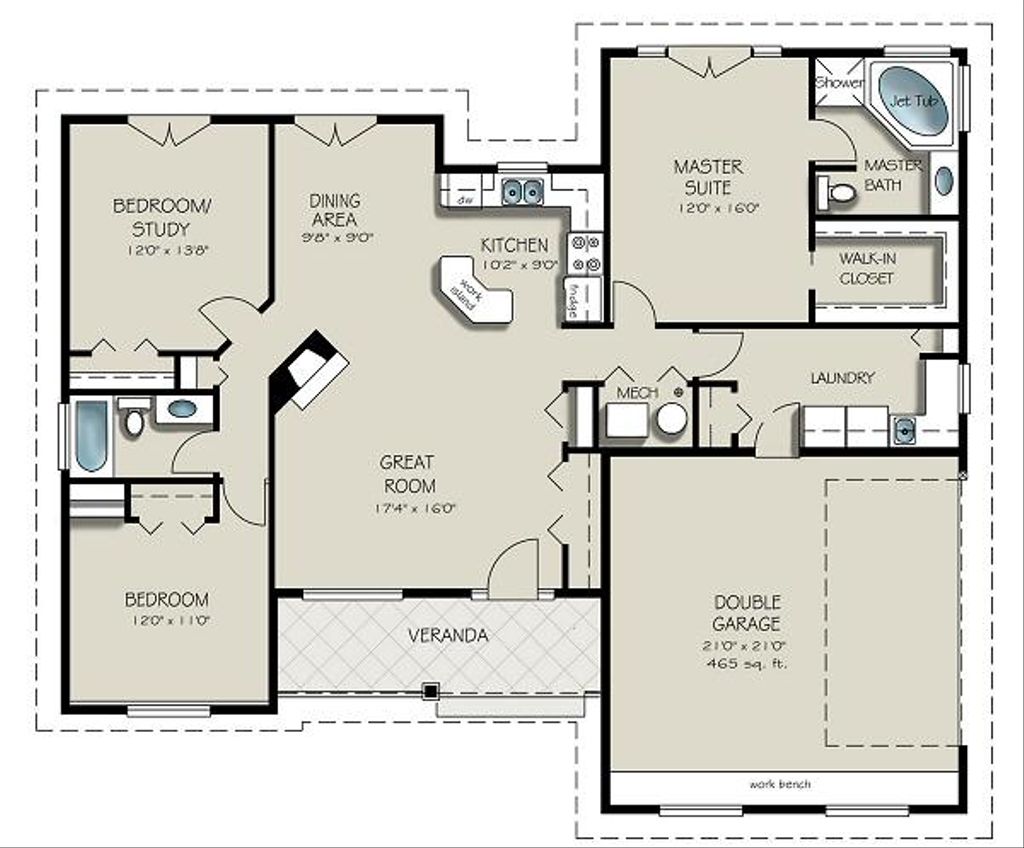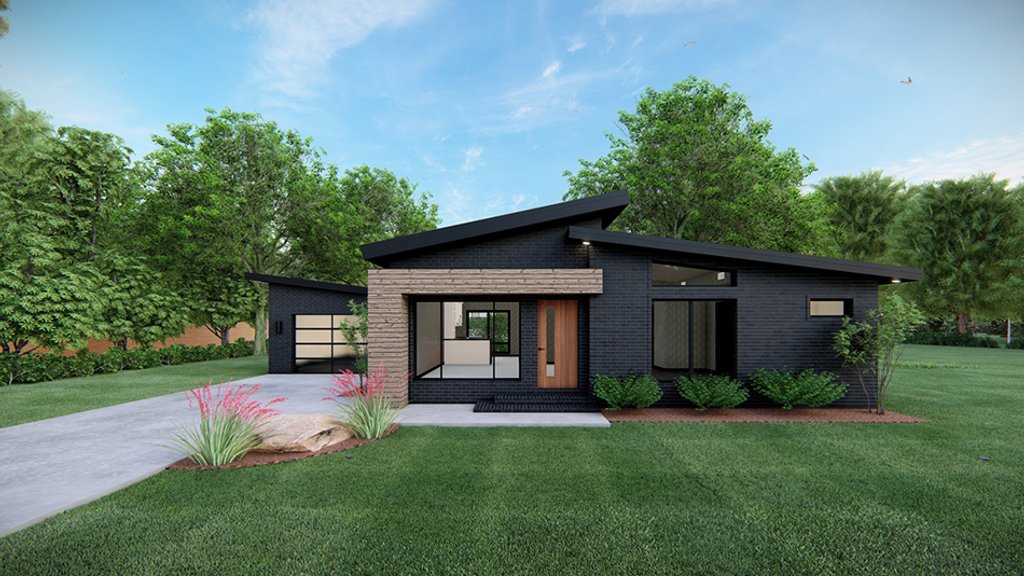Understanding the Basics: 3 Bedroom 2 Bath House Plans 1 Story

A 3-bedroom, 2-bathroom, single-story house plan represents a popular and practical home design, catering to a variety of lifestyles. It combines the convenience of a single level with sufficient space for a family or individuals seeking a comfortable living environment.
Typical Features and Layout Considerations
This type of home plan prioritizes functionality and efficient use of space. Common features include:
- Open-Concept Living Areas: These designs often feature an open layout encompassing the living room, dining area, and kitchen, promoting a sense of spaciousness and facilitating social interaction.
- Dedicated Bedrooms: Three bedrooms provide ample private space for family members or guests, allowing for individual retreat and relaxation.
- Two Bathrooms: The inclusion of two bathrooms enhances convenience and privacy, particularly for larger families or those who prefer separate spaces for morning routines.
- Kitchen Layout: The kitchen is typically designed with a focus on functionality and efficiency, incorporating features such as ample counter space, cabinets for storage, and appliances that meet the needs of the occupants.
- Laundry Room: A dedicated laundry room is commonly included, providing a convenient space for washing and drying clothes.
- Outdoor Living Space: Many single-story homes feature a patio, deck, or porch, offering an extension of the living area for outdoor relaxation and entertaining.
Benefits of Single-Story Design
Single-story homes offer several advantages, making them appealing to a wide range of homeowners.
- Accessibility: A single level eliminates stairs, making the home accessible for individuals of all ages and abilities, including those with mobility challenges.
- Ease of Maintenance: With everything on one level, cleaning and upkeep are simplified, reducing the time and effort required for household tasks.
- Lower Construction Costs: Single-story homes generally require less material and labor for construction, leading to potentially lower overall costs compared to multi-story designs.
- Energy Efficiency: The smaller footprint of a single-story home can contribute to improved energy efficiency, as there is less surface area to heat or cool.
- Outdoor Space: The absence of a second story often allows for a larger yard or outdoor living space, providing opportunities for gardening, recreation, or simply enjoying the outdoors.
Drawbacks of Single-Story Design
While single-story homes offer numerous benefits, it’s important to consider potential drawbacks.
- Limited Space: Single-story designs may have limitations in terms of overall square footage, which can be a concern for larger families or those who require significant storage space.
- Privacy: Depending on the layout and location, single-story homes may offer less privacy than multi-story homes, particularly in areas with close proximity to neighbors.
- Aesthetics: Some individuals may prefer the architectural appeal of multi-story homes, finding single-story designs less visually interesting.
Design and Functionality

Designing a 3-bedroom, 2-bathroom home involves considering the layout, functionality, and style to create a comfortable and efficient living space. This section explores popular layouts, space-maximizing techniques, and architectural styles commonly incorporated into these plans.
Popular Layouts
The layout of a 3-bedroom, 2-bathroom home plays a crucial role in determining the flow and functionality of the space. Here are some common layout variations:
- Open Concept: This layout emphasizes a seamless flow between the living, dining, and kitchen areas, creating a spacious and inviting atmosphere. The open concept design is particularly popular in modern homes, maximizing natural light and fostering a sense of openness.
- Traditional Layout: This layout features distinct rooms for each function, including separate living, dining, and kitchen areas. This provides privacy and separation between spaces, offering a more traditional and formal feel.
- Split-Level: This layout incorporates a split-level design, with different areas of the house situated at varying heights. This often features a living room or family room on a lower level, while bedrooms are located on a higher level, offering a unique and visually appealing design.
Maximizing Space
Space maximization is essential in any home, especially in smaller homes. Here are some design ideas for creating a functional living experience:
- Multi-Functional Spaces: Consider incorporating multi-functional furniture pieces, such as a sofa bed in the living room or a dining table that doubles as a workspace. This maximizes space and versatility within each room.
- Built-In Storage: Utilize built-in shelves, cabinets, and drawers to create ample storage solutions, minimizing clutter and maximizing available space.
- Vertical Space: Maximize vertical space by incorporating tall cabinets, shelves, and wall-mounted storage units. This helps to keep items organized and off the floor, creating a more spacious feel.
Architectural Styles
The architectural style of a home can significantly impact its overall aesthetic and functionality. Here are some popular architectural styles commonly incorporated into 3-bedroom, 2-bathroom home plans:
- Modern: Modern homes are characterized by clean lines, simple forms, and an emphasis on functionality. They often feature large windows, open floor plans, and a minimalist aesthetic.
- Contemporary: Contemporary homes share similarities with modern styles but incorporate more eclectic elements and a focus on current trends. They often feature unique materials, bold colors, and a blend of traditional and modern design elements.
- Traditional: Traditional homes are characterized by classic details, symmetrical facades, and a focus on craftsmanship. They often feature gabled roofs, columns, and a sense of permanence and stability.
- Mediterranean: Mediterranean homes are inspired by the architecture of the Mediterranean region. They often feature stucco walls, terracotta roofs, arched doorways, and a warm and inviting aesthetic.
- Ranch: Ranch homes are characterized by a single-story design, low-pitched roofs, and open floor plans. They are often popular for their affordability, ease of maintenance, and family-friendly layout.
Layout Variations
| Layout Variation | Advantages | Disadvantages | Sample Floor Plan Illustration |
|---|---|---|---|
| Open Concept | Spacious and inviting, maximizes natural light, fosters a sense of openness | Lack of privacy, potential for noise carryover between spaces | [Sample floor plan image description: A visual representation of an open concept layout showcasing a seamless flow between the living, dining, and kitchen areas. The layout emphasizes a spacious and inviting atmosphere with large windows allowing ample natural light.] |
| Traditional Layout | Provides privacy and separation between spaces, offers a more traditional and formal feel | Can feel more cramped and less inviting, may not maximize natural light | [Sample floor plan image description: A visual representation of a traditional layout featuring distinct rooms for each function, including separate living, dining, and kitchen areas. The layout emphasizes privacy and separation between spaces with distinct room boundaries and defined entryways.] |
| Split-Level | Unique and visually appealing design, offers a sense of separation between different areas of the house | May be challenging to navigate for individuals with mobility limitations, can be more expensive to build | [Sample floor plan image description: A visual representation of a split-level layout with different areas of the house situated at varying heights. The layout features a living room or family room on a lower level, while bedrooms are located on a higher level, offering a unique and visually appealing design with distinct levels and stairways connecting different areas.] |
Construction and Considerations

The construction phase of your single-story 3-bedroom, 2-bathroom house plan involves several critical considerations, including the foundation, roofing, building materials, and energy efficiency. Carefully planning these aspects will ensure a durable, comfortable, and cost-effective home.
Foundation Types
The foundation is the base of your house, supporting its weight and transferring loads to the ground. The type of foundation best suited for your project depends on factors like soil conditions, climate, and budget. Here are some common foundation types:
- Slab foundation: This is a single, poured concrete slab that serves as the floor and foundation. It’s common in areas with stable soil and minimal frost. Slab foundations are typically cost-effective and quick to construct.
- Crawlspace foundation: This foundation creates a space between the ground and the floor, allowing for access to utilities and potential storage. Crawlspaces are more common in areas with moderate soil conditions and some frost.
- Basement foundation: This foundation provides a fully enclosed, below-ground space that can be used for living areas, storage, or utilities. Basements are often preferred in areas with cold climates and require excavation and waterproofing.
Roofing Options
The roof protects your home from the elements and contributes significantly to its overall aesthetic. Choosing the right roofing material depends on factors like budget, climate, and desired lifespan. Some popular roofing options include:
- Asphalt shingles: This is a cost-effective and widely available option, offering a variety of styles and colors. Asphalt shingles have a moderate lifespan and require regular maintenance.
- Metal roofing: Metal roofs are durable, long-lasting, and energy-efficient. They are often more expensive than asphalt shingles but offer excellent fire and wind resistance.
- Tile roofing: Tile roofs are known for their durability, longevity, and aesthetic appeal. They are more expensive than asphalt shingles and metal roofs but can last for decades.
Building Materials, 3 bedroom 2 bath house plans 1 story
The choice of building materials significantly impacts the cost, durability, and energy efficiency of your home. Consider the following options:
- Wood framing: This is a traditional and cost-effective method of framing, using lumber to create walls and roofs. Wood framing is versatile and allows for easy customization.
- Steel framing: Steel framing is becoming increasingly popular due to its strength, durability, and resistance to fire and pests. It can be more expensive than wood framing but offers long-term benefits.
- Concrete block: Concrete block walls are durable and fire-resistant, offering excellent sound insulation. They can be more expensive than wood framing but provide a sturdy and long-lasting structure.
Ventilation and Insulation
Proper ventilation and insulation are crucial for maintaining a comfortable and energy-efficient home. Ventilation allows for fresh air circulation and moisture control, while insulation reduces heat loss in winter and heat gain in summer.
- Ventilation: Attic ventilation, bathroom fans, and kitchen exhaust hoods are essential components of a well-ventilated home. They help prevent moisture buildup and ensure a healthy indoor environment.
- Insulation: Insulation is installed in walls, ceilings, and floors to reduce heat transfer. Common insulation materials include fiberglass, cellulose, and spray foam. Choosing the right insulation level for your climate and budget is crucial for energy efficiency.
Cost Considerations
The cost of building a 3-bedroom, 2-bathroom house varies significantly based on location, building materials, finishes, and labor costs. However, you can expect a range of $150 to $300 per square foot.
For example, a 1,500 square foot house could cost between $225,000 and $450,000.
Accessibility and Future Modifications
Accessibility and future modifications should be considered during the planning phase. This ensures your home can accommodate potential changes in your needs or those of future residents.
- Accessibility: Consider features like wider doorways, ramps, and accessible bathrooms to accommodate individuals with mobility limitations.
- Future Modifications: Designing for flexibility allows for easy future renovations, such as adding a room or adapting for aging in place. This could involve planning for additional electrical outlets, plumbing lines, or structural reinforcements.
3 bedroom 2 bath house plans 1 story – When designing a 3 bedroom 2 bath house plan on one story, the bathroom vanities are a crucial element to consider. A stylish touch can be added with a dark blue bathroom vanity unit , which brings a touch of sophistication and modern appeal to the space.
This choice complements the overall design and creates a welcoming ambiance in the bathrooms, reflecting the overall aesthetic of the 3 bedroom 2 bath house plan.
When designing a 3 bedroom 2 bath house plan on one level, the master bathroom often becomes a focal point. You might consider a master bathroom floating vanity to create a modern and spacious feel. This element can elevate the overall design of your one-story home, adding a touch of sophistication to the master suite.